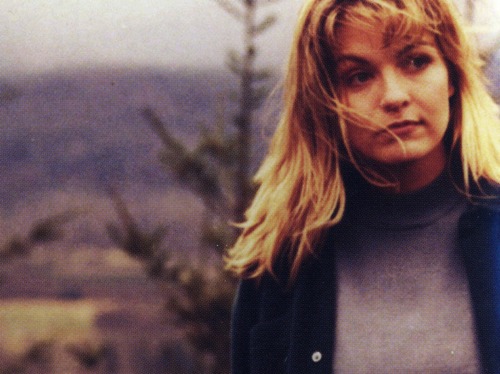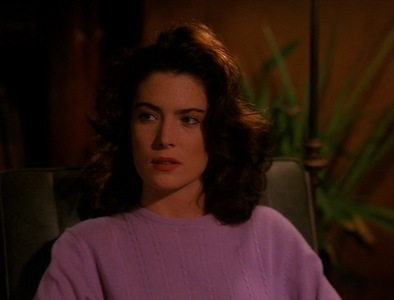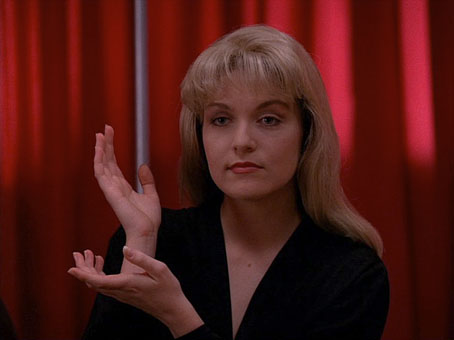I was, and remain to this decade, an ardent Twin Peaks fan. From the moment Laura Palmer’s naked corpse was discovered wrapped in plastic on the bank of a river and subsequently FBI Special Agent Dale Cooper arrived in the sleepy town to investigate, I was completely hooked.
What begins as a murder mystery turns into a complex unravelling of lives in this small residence as Laura’s death sets off a remarkable chain of events and the quiet sleepy town falls apart at the seams.
Lynch’s work in my opinion was a TV revolution. It was complex and elliptical and interlaced with so many elements of genius that I found absolutely fascinating. I was obsessed. There are far too many strands to note in this blog post; there were 30 episodes after all and I want to hold your attention. Besides, I want you to watch the series from start to finish and become entranced yourself.
The owls are not what they seem...
Firstly, I loved the utter surrealism. This was no ordinary murder mystery after all; there were eerie visions and evil spirits, a one-armed Man named Mike, a dwarf in a red business suit who spoke in reverse, a giant who provides clues to the murderer in visions, and those dense, ominous woods that surrounded Twin Peaks and provided the setting for many of the strange, other-wordly goings on. I became entangled in those dark, dense woods just watching.
Then there was the evil BOB who appeared in visions and absolutely terrified the heck out of me. Still does in fact - sometimes when I'm alone in the house happily reading or watching TV, an image of that grey-haired man and that grubby denim jacket suddenly pops into my head and I have to put a few more lights on, turn the music up just a little bit louder. Call my Mum. That sort of thing.
The late Frank Silva, who played BOB, actually became a key character in the series purely by chance. When production began on the pilot for Twin Peaks, the series creators Lynch and Mark Frost decided that Laura Palmer's dad would be the murderer. It was only during the filming of a scene in the pilot that took place in Laura's room, that Silva, a set dresser, accidentally trapped himself in the room by moving a dresser in front of the door. Lynch, being Lynch, liked the idea of this and filmed him crouched at the foot of Laura's bed, looking through the bars of the footboard, as if he were "trapped" behind them. In fact, he liked it so much he decided to make Silva part of the series.
Later that same day, a scene was being filmed in which Laura's mother experiences a terrifying vision although the script doesn't indicate what she sees. Lynch liked the scene, but was informed by a crew member that it would need to be re-shot as a mirror in the scene had inadvertently picked up someone's reflection. That person was Silva, there was no need to re-shoot, and the rest is history. It was crazy but it was David Lynch and therefore it all made perfect sense.
Falling into the music...
There was the soundtrack, composed by the great Angelo Badalamenti (who recently wrote the screen play for Drive) and David Lynch in 1989. It managed to be both eerie and enthralling at the same time and evoked the moods and emotions that played out so dramatically throughout the series. Apparently, in 20 minutes they produced the signature theme for the series and Lynch told Badalamenti "you just wrote 75% of the score. It's the mood of the whole piece. It is Twin Peaks". The music is characterised by haunting melodies, throbbing bass and jazz and light percussion. The theme song 'Falling' still creates goose bumps and has found its way onto my Spotify playlist along with the rest of the soundtrack.
Population 15,201...
There was the enigmatic characters – seemingly ordinary people going about their own business but really complex individuals who were hiding many secrets of their own. The esoteric Agent Dale Cooper who appeared in all of the episodes, including the pilot, was the character that stood out for me with his unorthodox investigatory methods and his love of the rural town. Lynch casted several veteran actors who had found fame in the 1950s and 1960s in the series, including film stars such as Richard Beymer who played the wealthy business man Ben Horne and was well known as playing Tony in West Side Story. Piper Laurie played the adulterous and scheming Catherine Martell who made her name in Hollywood playing alongside Ronald Regan, and British actor James Booth best known for Zulu and Coronation Street played Ernie Niles whose criminal past catches up with him in Season 2.
Most of the characters were hiding some sort of secret beneath their day to day personas, none more so than the troubled Laura Palmer, who we learn was leading a shocking double life - homecoming queen and loving daughter on the outside, cocaine addict, prostitute and manipulator in the secret life she led deep within those dark woods.
The Women of Twin Peaks....
Mostly, I wanted to be in Twin Peaks. I wanted to live there, in that sleepy little Washington town and look like any one of those girls that made the show. I was particularly struck by the glossiness of the female characters - the sultry, beautiful girls who looked like old movie stars, were vulnerable but tough and completely bewitched all of the men that lived there.
Sheryl Lee played the infamous Laura, with soft blonde hair, a perfect smile and sad haunting eyes that hid so many terrible secrets.
Lara Flynn Boyle played Donna Hayward, the good-girl-turned-bad following the death of her best friend, with chestnut, tumbling curls, red lips and porcelain skin set againt soft fitted jumpers worn in muted tones.
Audrey Horne personified the 50s glamour look that has had such a resurgence in recent times. With short black curls, dark red lips and striking eyes she mesmerised Agent Cooper with her Elizabeth Taylor looks and sultry movements.
 Madchen Amick played Shelly Johnson, the long suffering wife of violent Leo with never ending wavy hair, striking eyes and a captivating appeal.
Madchen Amick played Shelly Johnson, the long suffering wife of violent Leo with never ending wavy hair, striking eyes and a captivating appeal.
Lana del Rey, eat your heart out.
Clever pieces of a complex puzzle....
There were many elements to the Twin Peaks story that captivated the audience beyond the series itself. The film 'Twin Peaks: Fire Walk with Me', can be viewed as both an epilogue and a prologue and provides us with an insight into the last seven days in the life of Laura Palmer. Agent Cooper's autobiography, presented as diary transcripts from his infamous tape recordings ends with the news of Laura Palmer's murder and Cooper 'Heading for a little town called Twin Peaks...'
The Secret Diary of Laura Palmer contains important clues to the identity of her killer and serves as prequel to the Twin Peaks story. In the book we discover how her inner demons drove her to use everyone around her - her best friend, her family and neighbours and mostly all those boys and men who fell under her spell. It was a fascinating glimpse into an innocent girl who became amoral and we find out exactly why she displayed such wild behaviour. It's shocking, descriptive and an absolute page turner.
Twin Peaks sadly ended with an unresolved cliff-hanger but the magic of a series that featured murder, incest and demonic possession lives on over 25 years later in my eyes. You can see it's influence in TV and modern filmmaking, in fashion and beauty and David Lynch still continues to mystify and enthrall, recently putting his directing skills to good use in a campaign for Dom Pérignon. There are blogs (my favourite is http://welcometotwinpeaks.com/), fact-filled web pages, endless memorabilia and there’s even a festival, Twin Peaks Fest, in August 2012 and held around North Bend, WA. Now that would be interesting.
I’m signing off now. It’s getting very dark outside and I can almost smell the pineferns and hear the owls flapping (although they aren’t what they seem). I’m going to pour myself a damn fine cup of coffee, turn out the lights and transport myself back to Twin Peaks, population 51,201. It may take me a while to get to sleep tonight and I’m certainly not going anywhere near the sofa, but it was all absolutely worth it.







No comments:
Post a Comment